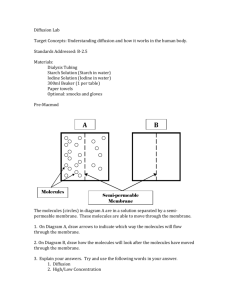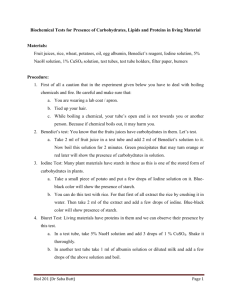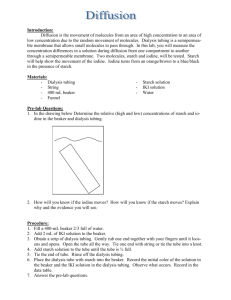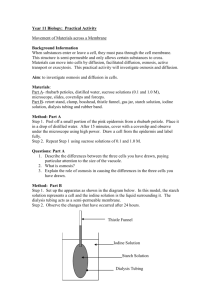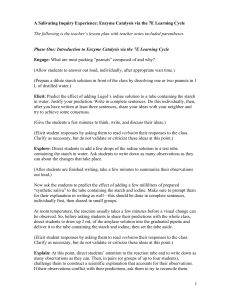Diffusion across a semi-permeable membrane
advertisement
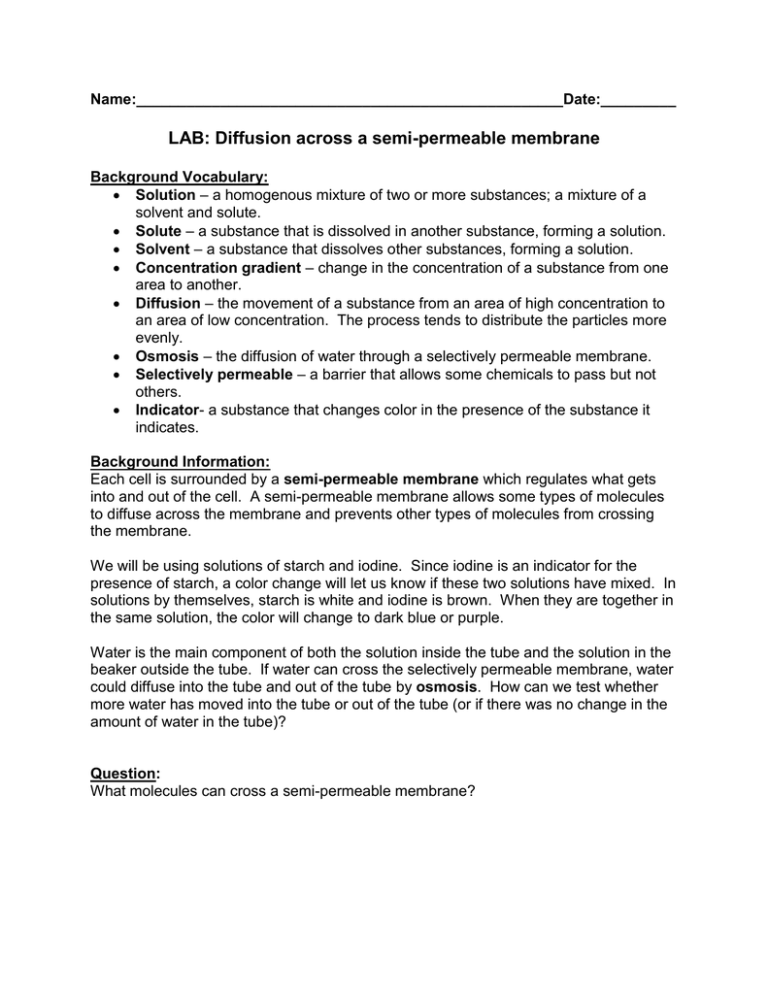
Name:___________________________________________________Date:_________ LAB: Diffusion across a semi-permeable membrane Background Vocabulary: Solution – a homogenous mixture of two or more substances; a mixture of a solvent and solute. Solute – a substance that is dissolved in another substance, forming a solution. Solvent – a substance that dissolves other substances, forming a solution. Concentration gradient – change in the concentration of a substance from one area to another. Diffusion – the movement of a substance from an area of high concentration to an area of low concentration. The process tends to distribute the particles more evenly. Osmosis – the diffusion of water through a selectively permeable membrane. Selectively permeable – a barrier that allows some chemicals to pass but not others. Indicator- a substance that changes color in the presence of the substance it indicates. Background Information: Each cell is surrounded by a semi-permeable membrane which regulates what gets into and out of the cell. A semi-permeable membrane allows some types of molecules to diffuse across the membrane and prevents other types of molecules from crossing the membrane. We will be using solutions of starch and iodine. Since iodine is an indicator for the presence of starch, a color change will let us know if these two solutions have mixed. In solutions by themselves, starch is white and iodine is brown. When they are together in the same solution, the color will change to dark blue or purple. Water is the main component of both the solution inside the tube and the solution in the beaker outside the tube. If water can cross the selectively permeable membrane, water could diffuse into the tube and out of the tube by osmosis. How can we test whether more water has moved into the tube or out of the tube (or if there was no change in the amount of water in the tube)? Question: What molecules can cross a semi-permeable membrane? Hypothesis: Describe your prediction for the movement of starch, iodine, and water molecules. Starch: Iodine: Water: Describe what evidence in the lab will show you that your prediction has happened. Starch: Iodine: Water: Procedures: 1. Obtain one piece of dialysis tubing. The tubing should be soaked in water for a minute or more. 2. At the very bottom tie a knot tightly to create a bag. 3. To open the other end of the tube, rub the end between your fingers until the edges separate. Using a pipet, add some starch solution to the tube. 4. After the starch solution has been added, squish out the air and tie a knot tightly in the other end of the tubing. 5. Rinse off the tube in fresh water. Make sure that there is no starch solution on the outside. Dry it off. 6. Find the mass of the tube and starch solution and record it in your observations under “Initial State”. 7. Add 150 mL of water to a 200 mL beaker. Make sure you don’t add extra water. 8. Add about 25 drops iodine to the water in the beaker. Be careful to avoid staining your clothes or fingers with the iodine. 9. Record your observations of the colors of the solution in the tube and the solution in the beaker in the “Initial State” drawing below. 10. Put the tube into the beaker. 11. Wait for a half hour or more. 12. In the “Final State” drawing, record your color observations. 13. Remove the tubing, dry it off, and record its mass. Observations: Draw a diagram showing your lab set-up. Make sure to label where the starch is and where the iodine is. You should also include the mass of the tubing. Initial State: Final State: Analysis: 1. Did starch move out of the tube? How do you know? 2. Did iodine move into the tube? How do you know? 3. Did water move in or out of the tube? How do you know? Conclusion: 1. Explain how your observations support the conclusion that dialysis tubing is a semi-permeable membrane. 2. What factor determined which molecules could diffuse and which ones could not? 3. Use your understanding of osmosis to explain why the water molecules moved the way they did.
